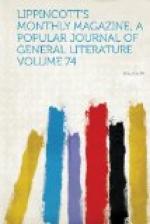[Illustration: CIVITA Bagnorea.]
We stopped to lunch at Viterbo, a town more closely connected with the history of the Papacy than any except Rome itself, and full of legends and romantic associations: it is dirty and dilapidated, and has great need of all its memories. Being but eight miles from Montefiascone, we called for a bottle of the fatal Est, which we had tasted once at Augsburg, where the host of the Three Moors has it in his cellar, in honor perhaps of the departed Fugger family, whose palace has become his hotel: there we had found it delicious—a wine as sweet as cordial, with a soul of fire and a penetrating but delicate flavor of its own—how different from the thin, sour stuff they brought us in the long-necked, straw-covered flask, nothing to attest its relationship to the generous juice at the Three Moors except the singular, unique flavor! After this little disappointment we left Viterbo, and drove on through the same sort of scenery, which seemed to grow more and more beautiful in the rosy light of the sinking sun. But it is hard to tell, for nothing makes a journey so beautiful as to know that Rome is the goal. As the last rays were flushing the hill-tops we came in sight of Orte, with its irregular lines of building clinging to the sides of its precipitous cliff in such eyrie-wise that it is difficult to say what is house and what is rock, and whether the arched passages with which it is pierced are masonry or natural grottoes; and there was the Tiber—already the yellow Tiber—winding through the valley as far as eye could follow. Here we waited for the train, which was ten minutes late, and tried to make up for lost time by leaving our luggage, all duly marked and ready, standing on the track. We soon began to greet familiar sites as we flitted by: the last we made out plainly was Borghetto, a handful of houses, with a ruined castle keeping watch on a hill hard by: then twilight gathered, and we strained our eyes in




